Anyone who follows digital music or anime culture must be familiar with Hatsune Miku, the virtual idol whose voice shaped an entire generation of songs and became a global phenomenon with a massive fanbase.
But have you ever wondered how you can make a Hatsune Miku voice yourself? The original process used advanced voicebank sampling. But several Miku voice generators today can also help anyone experiment with her sound and bring it to their own project.
Let's take a closer look at how you can recreate that signature Miku voice!
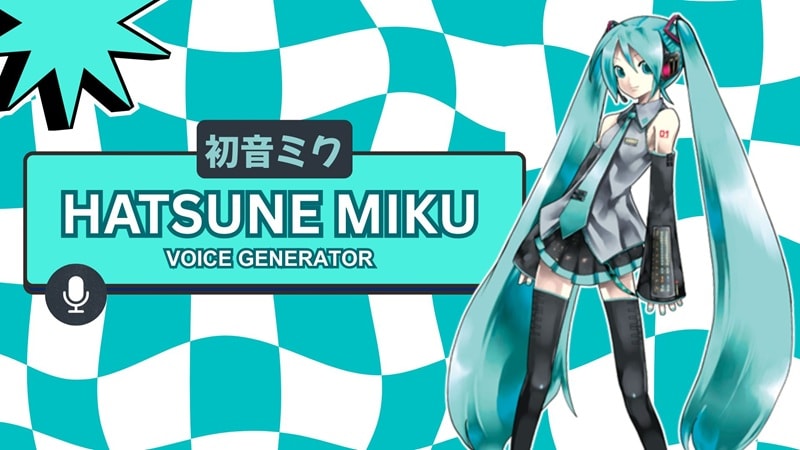
Part 1. Vocaloid's Hatsune Miku and Her Popularity
When Crypton Future Media launched Hatsune Miku in 2007, nobody would have predicted she'd redefine what it means to be a pop star. With her iconic teal twin pigtails, futuristic outfit, and unmistakable high-pitched tone, Miku became the beginning of a new era in digital music.
Unlike traditional idols managed by labels, Miku was born from Vocaloid software, designed to let anyone compose music using her voicebank.
Hatsune Miku's Popularity
With how widely she's recognized today, it's not an exaggeration to say that Miku is a global icon. She might've started as a digital voicebank, but her influence quickly expanded far beyond the screen.
- Concerts with hologram performances: From Tokyo to Los Angeles, Miku performs in sold-out digital concerts that blend animation and real-world energy in a way no artist has before.
- Viral songs like World is Mine and Senbonzakura (千本桜): These fan-made hits turned her into a household name online, sparking countless covers and remixes.
- A global fanbase that never sleeps: Miku's fan community produces endless remixes, covers, artwork, and even memes, which keep her presence alive across every platform imaginable.
What made her extraordinary was the open, crowdsourced creativity behind her rise. It's her fans who are the producers, writers, and visual artists who build an entire universe around her. And who knows, you might be the next one to join in!
Part 2. How Vocaloid Creates Hatsune Miku's Voice
We've briefly mentioned that Hatsune Miku was born from Vocaloid. Vocaloid is a singing voice synthesizer that turns text and melody into song using a recorded voicebank, one of which is Hatsune Miku.
So, if you wonder how to create Miku's voice, the original method is by using the Vocaloid software. But, you can also create a Miku AI voice using the tools we are going to cover later.

The process involved several steps:
- Install the Vocaloid editor and make sure you have Hatsune Miku's voicebank installed. This voicebank contains all the vocal data that makes up her sound.
- In the piano roll, write your melody notes and type the lyrics that Miku will sing. Vocaloid automatically converts those lyrics into phonetic sounds based on her Japanese or English voicebank.
- Fine-tune parameters like pitch, tone, vibrato, dynamics, and breathiness. These adjustments bring emotion and realism to her voice, so your song can sound more natural.
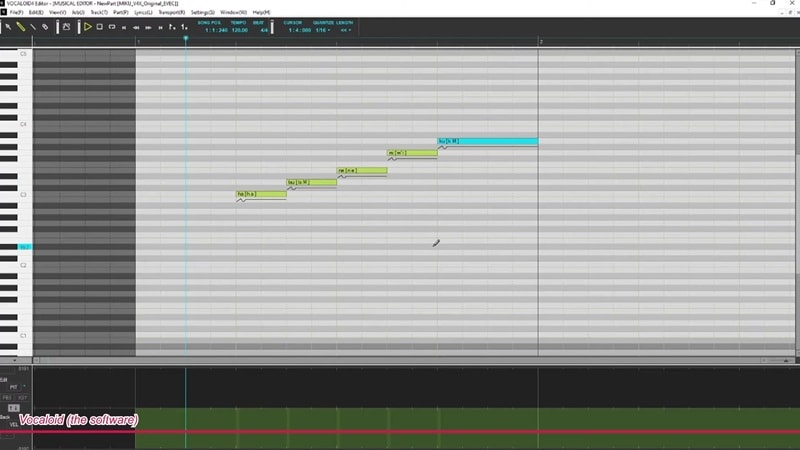
Though Vocaloid offers the most authentic way to recreate Miku's voice, it still comes with a few limitations for your consideration:
- It's paid software. You'll need to purchase both the Vocaloid editor and the Hatsune Miku voicebank, which can be quite expensive.
- It's not very beginner-friendly. The interface and tools can feel overwhelming at first, especially if you're new to music production or digital composition.
- It requires musical knowledge. To get the best results, you'll need a basic understanding of melody, rhythm, and audio mixing to make Miku's voice sound natural and expressive.
Part 3. Miku AI Voice Generator Alternatives to Vocaloid
For users who don't want to deal with the complexity or cost of Vocaloid, using Miku AI voice generators makes the process much easier. You can create vocals that sound similar to Hatsune Miku's voice by just typing text or uploading audio.
1. TopMedia AI – Free AI Hatsune Miku Voice Generator
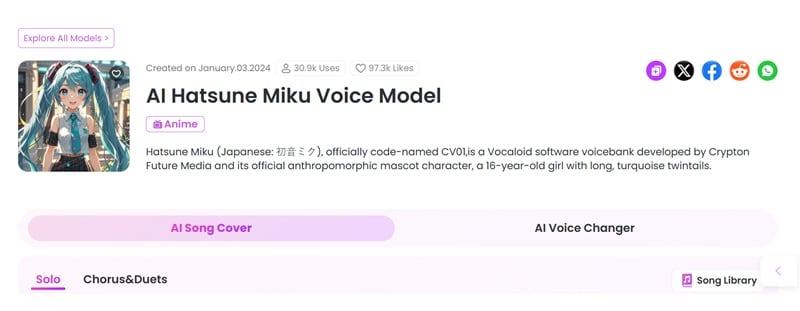
TopMedia AI is a web-based AI voice generator that features a Hatsune Miku-style voice among other characters. You can either convert and change an existing audio file into Miku's voice or generate a brand-new voice line from text input. You can also create AI song covers, whether as a solo performance or a duet, using another voice model.
- Advanced settings for song covers, including pitch and reverb control.
- Lets you paste YouTube links to generate AI song covers automatically.
- Supports most common audio formats (MP3, WAV, FLAC, etc.).
- The output quality can sound slightly robotic.
- Free users are limited to only two generations before requiring a paid plan.
- The maximum duration is limited to 7 minutes.
- Free version available
- Paid plans start from $4.99/week
2. Filme – Hatsune Miku Voice Generator from Texts
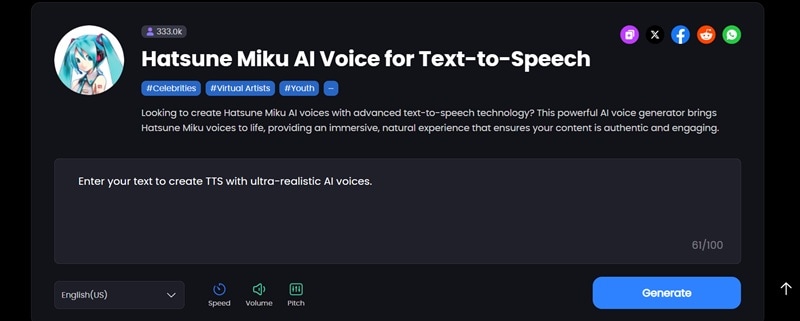
Filme is an AI-powered video and voice editing tool available as both a desktop application and an online platform. It has a built-in Miku voice text-to-speech generator that lets you turn written text into Miku-style vocals. You can try generating the voice for free for up to 100 characters.
- You can adjust the speed, volume, and pitch for better voice control.
- Available in multiple languages, including English and Japanese.
- Simple with instant playback and preview.
- The free version is limited to short text lengths (up to 100 characters).
- Designed for spoken lines, not for singing or full music vocals.
- Free version available
- Paid plans start from $12.99/month
3. Jammable – Song Cover and Text-to-Speech Miku Voice Generator
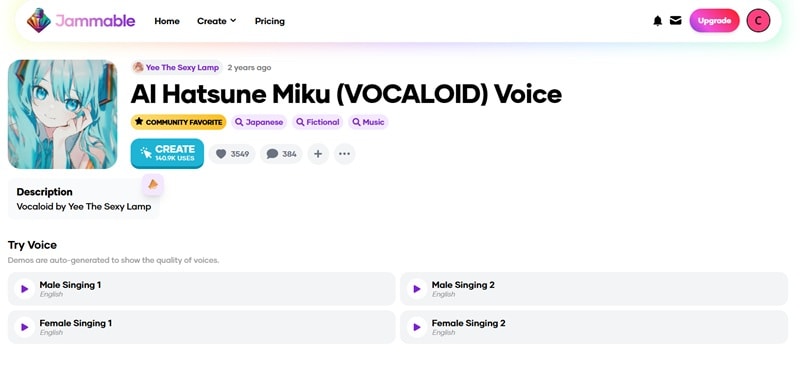
Jammable is an AI singing and voice generator that includes Hatsune Miku AI voice among its available voice options. You can upload an existing song, record your own vocals, or even type text that the AI will convert into Miku's voice. The platform also offers a large music library to choose from if you don't have your own track.
- Multiple input options.
- Includes preset effects for vocals and full tracks.
- No free version or trial.
- The voice sounds more robotic compared to other options.
- Limited control over tone and pronunciation.
Start from $8.99/month
Part 4. More Than Voice Generator: Introduction to AI Voice Editing in Filmora
While we have covered several Hatsune Miku voice generators, sometimes, you want to go beyond imitation. If you need to clean up background noise, match tone and timing, or blend your AI-generated vocals into a full video project, Wondershare Filmora presents a reliable solution to elevate your entire production.
Although Filmora is not a dedicated Hatsune Miku voice generator, it is a versatile editing software that covers every creative aspect, including audio, video, and image. Filmora comes with a text-to-speech tool, a voice modeling feature, and a complete suite of AI audio editing tools that simplify your workflow.
Text-to-Speech
Adding voiceovers to videos used to take hours of recording and editing. But with Filmora, you can generate high-quality voiceovers from text and choose from 10 voice styles and over 25 languages. Once created, your AI-generated voices can be embedded directly into your project without the need to switch between platforms.
AI Voice Modelling
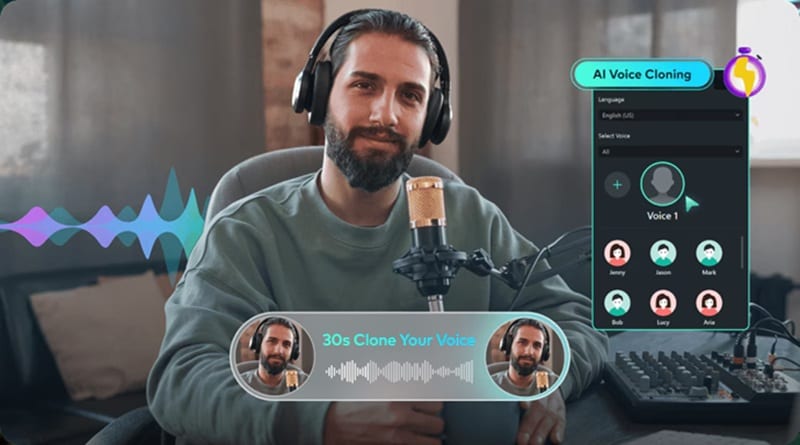
You can bring a personal touch to your AI voiceovers with Filmora's AI Voice Modeling feature. You can record and clone your voice once, then use it to generate speech in up to 16 languages within seconds. The AI accurately replicates your tone, pitch, and emotion, so you can create natural-sounding audio that feels truly yours whenever you need it.
AI Audio Editing Features
Filmora is also packed with tools that make audio editing faster, cleaner, and more intuitive, beyond just a simple voice generation.
- AI Audio Denoise: Instantly remove unwanted background sounds like humming, wind, or chatter for crystal-clear audio.
- AI Voice Enhancer: Automatically refine vocal quality by balancing tone, boosting clarity, and making them sound natural and professional without extra plugins.
- Silence Detection: Save time by letting Filmora detect and trim silent pauses automatically.
- Advanced Audio Editing Tools: Fine-tune your sound with adjustable pitch, equalizer settings, audio ducking, and VST plugin support, among other things, for professional mixing.
Conclusion
Hatsune Miku's voice has inspired millions of creators to explore what's possible when music meets technology. And to recreate Hatsune Miku's voice, modern Miku voice generators are available today that make the process simpler without needing deep technical knowledge.
If you need to take your creation further, you can start by using Filmora as your all-in-one AI voice and video editor. It lets you refine your Miku-inspired audio with tools like AI Voice Modeling, AI Audio Denoise, and Text-to-Speech, while also giving you full creative control over your project.
Frequently Asked Questions
-
Can I use Hatsune Miku AI voice for commercial projects?
It depends on the platform you use. Although Hatsune Miku's success came from community-driven projects, the original Hatsune Miku voicebank from Crypton Future Media is protected by copyright and can't be used commercially without proper licensing. -
Do Miku voice generators support multiple languages or only Japanese?
While the official Vocaloid Miku voicebank mainly supports Japanese and English, most AI-based Miku voice generators today can handle multiple languages through text-to-speech systems. -
Can I make real-time speech with a Miku AI voice generator?
Most Miku-style generators currently work through typed text or uploaded audio. You need to record or upload files first, then apply the Miku voice. -
How can I make sure I'm using a Miku voice generator legally and safely?
Always download from the official websites or trusted platforms, and review the terms of service before using Miku's likeness or voice commercially. Avoid using unofficial clones or redistributed voice banks, since they may violate Crypton Future Media's copyrights.


